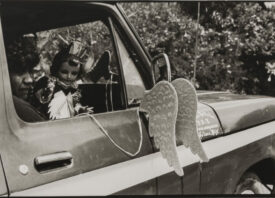Search this site
The Many Uses of Images in Photography Therapy

When working with teenagers at a residential facility a few years ago, the certified art therapist Ariel Landrum invited the teens to chart their recovery journey through photographs. For reasons relating to confidentiality, photography is strictly controlled in recovery facilities; when I was seventeen, I was hospitalized for OCD myself, and I remember that cameras were generally not allowed. Still, Landrum found a way to make photography therapy work in this setting: “While not featuring them directly, the photographs captured their activities and experiences, visualizing their path toward healing,” she tells me.
Throughout her practice with teens and adults, Landrum has regularly incorporated photography in creative and inspiring ways. She’s invited veterans to use their cameras as a tool for processing moral injury. She’s urged adults to embrace their “inner child” by taking photos from the perspective of a child. As part of her work in gender-affirming talk therapy, she’s also encouraged trans clients to express themselves and visualize their identities through self-portraiture and collage.
Whether they’re working with existing photographs (such as family photo albums) or encouraging clients to get outdoors and shoot something new, therapists continue to find new ways to use cameras as tools for healing, recovery, and introspection. We spoke with a group of professionals from diverse backgrounds—ranging from art therapists to MDs to hypnotherapists—about photography, therapy, and the surprising ways in which they overlap in their day-to-day work with clients.
Evoking memories
Instead of asking her clients to go out and create new photographs, Marissa Moore, a licensed professional counselor and therapist in Missouri, encourages them to bring in photographs they already own. These can be family photos, childhood snapshots, pictures of significant life events, or photos of important places or objects.
“By sharing photographs, we can explore the stories and experiences behind them and deepen our understanding of a client’s personal journey,” Moore explains. “We can discuss the context and significance of each image and explore the emotions and thoughts they elicit. This process can help uncover underlying themes, patterns, or connections that may be relevant to current struggles or goals.
“The client has complete control over what they choose to share, and there is no pressure to disclose anything that makes them uncomfortable. The goal is to create a safe and supportive space where they feel empowered to explore and express themselves.”
The New York, New Jersey, and Washington DC-based therapist Priscilla Chin also works with family and childhood photos. “Clients bring old family photos to therapy as a way to explore childhood experiences, access memories, and gain insights into past versions of themselves,” she says.
“These photos can evoke emotions and sensations that might have been buried or forgotten. By looking at photos of themselves at a specific age, clients can reconnect with their younger selves and gain a deeper understanding of their thoughts, feelings, hopes, and needs at that time. This exploration can lead to insights into their current behaviors and patterns.”
Creating a safe space through photography therapy
“I also encourage clients to build a collage of photos representing feelings of safety, comfort, and joy,” Chin continues. “This is a way to create a visual representation of their safe space. Clients can add pictures of things, spaces, or places that evoke peace, such as an old teddy bear, an area in nature, or a mentor. Clients can also add positive affirmations through images representing their strengths and values. Adding to the collage over time allows it to evolve as a representation of their inner growth and healing.”

Processing grief
Some therapists, including the licensed psychologist Dr. Heather Taylor, will encourage clients to bring in personal photographs after experiencing a loss. “I primarily do grief and trauma work,” she explains. “I highly encourage my clients to share/bring in pictures of their lost loved ones. So often when we experience a loss, we have three days off from work, and then people stop talking about our loved ones who passed.
“Being able to bring in a photo(s) of their loved ones, to name them, to show them, is honoring and validating how much their loved one mattered. With the emergence of telehealth, it makes it easier to share those glimpses in the therapy space because they can share important pictures they keep around them or what you notice on walls, which can lead to conversations where the clients feel seen.”
Dr. Lee Ann Thill, a registered and board-certified art therapist, has also encouraged her clients to share photos after a death. Particularly in the case of companion animal grief and loss, which she explains is a type of “disenfranchised grief,” photographs of the animal can help reaffirm the importance of that animal’s life.
“Using photos in art therapy to process their loss counteracts disenfranchised grief and the idea that the animal was ‘just’ a dog, cat, etc.,” Dr. Thill says. “For the client, photos reveal how their companion was ‘someone’ with a personality, quirks, a meaningful life, and a family who loved them.
“Another option is creating a piece of memorial art—a mixed-media collage that includes photos. While a client makes the collage, we talk about the significance of the photos and I guide the conversation to help them process grief.”
Visualizing emotions through photography therapy
If a client shows an interest in the arts, the psychotherapist Sam Blumberg incorporates that passion into their work together. “Photography, just like any form of art, is expressive and significant to the individual behind the lens,” he tells me. “I have given clients who enjoy photography homework to capture photographs between sessions, and then we come together and discuss the images.”
In one case, he encouraged a professional portrait photographer to make pictures in nature. “This helped manage anxiety because you can’t control nature like you can an individual in front of you,” he explains.
“I have also had clients take pictures of things that make them happy, sad, anxious, etc., and then we have talked about them. Typically, it’s about highlighting the cognitive process behind the photograph and tying that into the emotional component of how the image makes them feel.”
Priscilla Chin, the therapist based in New York, New Jersey, and DC, might also invite clients to visualize their emotions by creating photos. “When clients are unable to express or understand their emotions fully, I encourage them to find or capture photos that represent their emotional states,” she says. “I’ve found this to be especially helpful for people who find that words can’t fully express the depth and nuances of their emotional world.”
Exploring self-image
Dr. Blen Tesfu, an MD and general practitioner, uses a wide variety of photo-based techniques with clients. Depending on the client’s needs, she might ask them to create new photos or bring in images they already have.
“Self-reflection and self-image are crucial aspects of therapy, and photography provides a powerful tool for exploration,” Dr. Tesfu explains. “I encourage clients to take self-portraits or select existing photographs that reflect their self-image and perception of themselves.
“By examining these images together, we can explore body image concerns, self-esteem issues, and identity formation. Clients gain a deeper understanding of their self-perception, challenge negative self-beliefs, and work towards self-acceptance and empowerment.”
Dr. Thill, the art therapist, also uses photography to explore and transform how clients view themselves. “Photography is also useful for clients dealing with body issues, such as body image dissatisfaction and chronic illness,” she tells us.
“I’ve encouraged clients with body-related concerns to consider working with a photographer to get portraits, a life event shoot, like for a birthday, or a boudoir shoot. That kind of experience can help clients see themselves differently and challenge ideas about beauty, presence, and claiming space.
“If they’re unable or reluctant to hire a photographer, another option is a photoshoot with a friend or partner. In therapy, we can talk about the images, the experience of taking them, and feelings that come up.
“I’ve also had clients do selfie collections between sessions. This could be a selfie series capturing different emotional states, or selfies in different life domains (at home and work, with family and friends), followed by discussion about the ways they perceive themselves and think they are seen by others. For people with chronic illness, we might use photos as a starting point to discuss life before and after diagnosis, or daily experience managing illness.”
Bonus: incorporating hypnosis
Dian Griesel, a certified clinical hypnotherapist, has teamed up with Charlotte Reardon, a therapeutic movement coach, to offer “Photo Hypnotherapy,” a type of hypnotherapy that incorporates movement and photography to build feelings of self-worth. Here’s how it works: after a conversational check-in, Reardon will guide the client through relaxing movements before they move into a studio located in their unique production space in New York City.
With Griesel and Reardon capturing photographs of the client throughout the session, they enter interactive hypnosis. The goal is to create a safe, collaborative space where clients can alter their perceptions and nurture their sense of self-worth. “Throughout the session, the subject is shown visuals of themselves that are coupled with affirming words,” Griesel explains. “Ultimately, the session concludes with the subject, themselves, verbally affirming positive observations of themselves.”
Parting thoughts
For Ariel Landrum, the certified art therapist, one of the reasons photography is so valuable is that it’s accessible to everyone, regardless of age or background. You don’t need much to start creating photos. “Teenagers, often using their phones, and adults, who are open to using any photography equipment, including film, have found unique ways to communicate,” she says. “I believe that photography, as a form of art therapy, offers a unique and profound way for individuals to express, explore, and understand their experiences.”
Finally, it’s important to note that this kind of work should only be done with the help of a trained professional and in accordance with ethical standards. Reach out to a professional if you need help.
“It’s important to note that the use of photography in therapy requires the therapist to have proper training and expertise in incorporating visual arts into the therapeutic process,” Dr. Tesfu clarifies. “Additionally, ethical considerations around confidentiality, consent, and the storage and use of photographs should be carefully addressed to ensure the well-being and privacy of clients.”
Further reading:
• Photography as Self-Therapy: An Introduction for Beginners
• Can Photography Help Depression?



